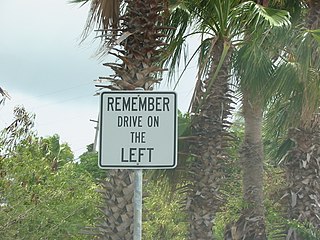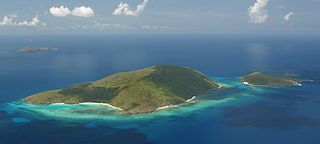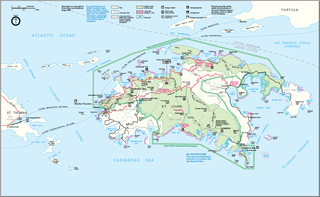
Politics of the United States Virgin Islands takes place in a framework of a presidential representative democratic dependency, whereby the Governor is the head of the territory's government, and of a multi-party system. United States Virgin Islands are an unincorporated and organized territory of the United States, administered by the Office of Insular Affairs of the United States Department of the Interior. Executive power is exercised by the local government of the Virgin Islands. The judiciary is independent of the executive and the legislature.

The United States Virgin Islands (USVI) is the only place under United States jurisdiction where the rule of the road is to drive on the left. However, virtually all passenger vehicles are left hand drive due to imports of U.S. vehicles.

Buck Island Reef National Monument protects Buck Island, a small, uninhabited 176-acre island about 1.5 miles (2.4 km) north of the northeast coast of Saint Croix, U.S. Virgin Islands, and 18,839 acres of submerged lands, totaling 19,015 acres. It was first established as a protected area by the U.S. Government in 1948, with the intention of preserving “one of the finest marine gardens in the Caribbean Sea.” The U.S. National Monument was created in 1961 by John F. Kennedy and greatly expanded in 2001 by Bill Clinton, over the opposition of local fishermen. Buck Island National Monument is one of few places in the Virgin Islands where brown pelicans and threatened least terns nest.

Saint John is one of the Virgin Islands in the Caribbean Sea and a constituent district of the United States Virgin Islands (USVI), an unincorporated territory of the United States.

Trunk Bay is a body of water and a beach on St. John in the United States Virgin Islands. Trunk Bay is part of the Virgin Islands National Park. Trunk Bay is named for the Leatherback turtle, which is endemic to the USVI and are locally known as trunks. The beach area is divided into two halves, the main Trunk Bay beach and swim area and Burgesman Cove which is located on the west end of Trunk Bay near Jumby Bay. Its amenities include a snack bar, showers and restrooms, a lifeguard, and an underwater trail for snorkeling its coral reef. Trunk Bay has consistently been voted one of the top beaches in the world.

Green Cay National Wildlife Refuge, encompasses the 6 ha (14 acre) island of Green Cay lying midway between the town of Christiansted and Buck Island Reef National Monument, just north of Saint Croix in the United States Virgin Islands of the Caribbean. It is administered as part of the Caribbean Islands National Wildlife complex. There is a smaller "Green Cay" off the coast of Saint Thomas.

Little Jost Van Dyke is one of the British Virgin Islands. It is a small island on the east end of the island of Jost Van Dyke. Like Jost Van Dyke, it takes its name from the Dutch privateer Joost van Dyk. It is the location of the Diamond Cay National Park, which includes the nesting grounds of wild boobies, terns and pelicans.

The Hans Lollik Islands are two islands in the U.S. Virgin Islands owned by Larry Page. In 2014, Page bought Great Hans Lollik Island ("GHL") and its smaller neighbor, Little Hans Lollik, for $23 million.
Waterlemon Cay is a small cay surrounded by a fringing reef located in Leinster Bay on Saint John, U.S. Virgin Islands. It is named after the water lemon.

Lovango Cay is a private island in the district of St. John, in the United States Virgin Islands.

Mingo Cay is a rugged, uninhabited, 48-acre (19 ha) island in the United States Virgin Islands. North of the Pillsbury Sound and measuring 0.7 miles (1.1 km) long, it is located 2 miles (3 km) northwest of the island of St. John and 2 miles (3 km) northeast of the island of St. Thomas. Administratively, it is part of the Central subdistrict of St. John.

The following is an alphabetical list of articles related to the territory of the United States Virgin Islands.

Carvel Rock is an uninhabited islet of the US Virgin Islands in the Caribbean, less than 2 acres in size. It is visited by boats as a scuba diving site, but its sheer cliffs and lack of a beach mean that landing would be practically impossible.

The fauna of the United States Virgin Islands consists of 144 species of birds, 22 species of mammals, 302 species of fish and 7 species of amphibians. The wildlife of the U.S.V.I. includes numerous endemic species of tropical birds, fish, and land reptiles as well as sea mammals. The only endemic land mammals are six species of native bats: the greater bulldog bat, Antillean fruit-eating bat, red fruit bat, Brazilian free-tailed bat, velvety free-tailed bat and the Jamaican fruit bat. Some of the nonnative land mammals roaming the islands are the white-tailed deer, small Asian mongoose, goats, feral donkeys, rats, mice, sheep, hogs, dogs and cats.
Ramgoat Cay is an islet in the United States Virgin Islands, located 310 yards northeast of Henley Cay and 1300 feet north of Hawksnest Point on the island of Saint John. It is 30 feet high and located within the Virgin Islands National Park.

Leduck Island is an island in the United States Virgin Islands, also spelled LeDuck Island, which is located 0.5 miles east of Sabbat Point in Johns Folly, separated from Saint John by the Sabbat Channel. LeDuck Island lies by the entrance to Coral Bay and is 85 feet high. Leduck Island is located within the Virgin Islands National Park and is one of the largest offshore islands to Saint John, along with Grass Cay and Congo Cay.
The St. Croix East End Marine Park (STXEEMP) was established to "protect territorially significant marine resources, and promote sustainability of marine ecosystems, including coral reefs, sea grass beds, wildlife habitats and other resources, and to conserve and preserve significant natural areas for the use and benefit of future generations." It is the U.S. Virgin Islands’ first territorially designated and managed marine protected area (MPA).

U.S. Virgin Islands Governor's Mansion may refer to any one of the three official residences owned by the government of the U.S. Virgin Islands and provided to the Governor of the United States Virgin Islands. One residence is located on each of the three largest inhabited islands of this U.S. territory in the Caribbean. The U.S. Virgin Islands maintains more official gubernatorial residences than any other state or territory of the United States.












